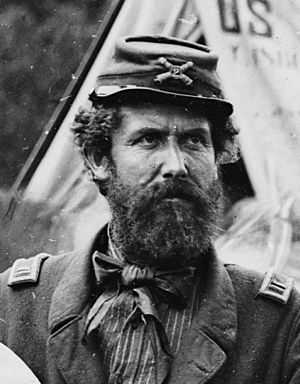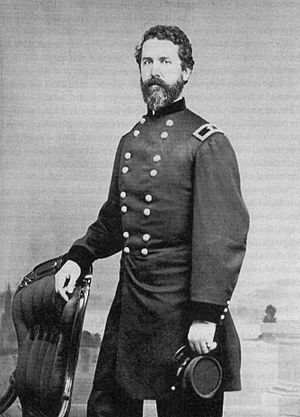John C. Tidball facts for kids
Quick facts for kids
John Caldwell Tidball
|
|
|---|---|
 |
|
| 3rd Commander of the Department of Alaska | |
| In office September 23, 1870 – September 19, 1871 |
|
| President | Ulysses S. Grant |
| Preceded by | George K. Brady |
| Succeeded by | Harvey A. Allen |
| Personal details | |
| Born | January 25, 1825 near Wheeling, Virginia (present-day West Virginia) |
| Died | May 17, 1906 (aged 81) Montclair, New Jersey |
| Resting place | West Point Cemetery West Point, New York. USA |
| Military service | |
| Allegiance | |
| Branch/service | Union Army |
| Years of service | 1848–1889 |
| Rank | |
| Unit | 2nd U.S. Artillery 4th New York Heavy Artillery 3rd U.S. Artillery 1st U.S. Artillery |
| Battles/wars | Third Seminole War American Civil War |
John Caldwell Tidball (born January 25, 1825 – died May 15, 1906) was an important officer in the United States Army. He was an artillery expert who served in the American Civil War. After the war, he became the military governor of Alaska, which was then called the Department of Alaska.
Contents
Early Life and First Steps in the Army
John Tidball was born near Wheeling, in what was then Virginia. He grew up on a farm in Ohio. He studied at the United States Military Academy at West Point, graduating in 1848. He was one of the top students in his class.
After West Point, he joined the U.S. Army as a second lieutenant. He served in the Third Seminole War, a conflict against the Seminole tribe in Florida. He also explored California in 1853 and 1854. In 1859, he helped the Army stop John Brown's raid at Harper's Ferry.
Serving in the Civil War
John Tidball served throughout the entire American Civil War. He earned five special "brevet" promotions for his bravery and excellent service. A brevet promotion is an honorary rank given for distinguished service, often without the pay or full command of that rank. President Abraham Lincoln himself praised Tidball for his work at the Battle of Gettysburg.
Tidball fought in many major battles in the eastern part of the war. These included battles from the First Battle of Bull Run all the way to the Siege of Petersburg.
When the war began, Tidball was a first lieutenant. He quickly became a captain in charge of his own artillery company. He was part of the famous U.S. Horse Artillery Brigade from 1861 to 1863. This unit was known for its fast-moving cannons.
In 1862, Tidball is believed to have started the tradition of playing "Taps" at military funerals. This bugle call is now a well-known part of military ceremonies.
Because promotions were slow in the regular army, Tidball also took on roles in the United States Volunteers. He became a colonel in the 4th New York Heavy Artillery Regiment in 1863. He commanded different brigades and artillery units during the war.
He led the artillery for the II Corps during the Overland Campaign in 1864. This included the fierce Battle of the Wilderness. He also served as the commandant (leader) of cadets at West Point for a short time. Later, he led the artillery for the IX Corps during the Appomattox Campaign.
For his brave service, President Lincoln nominated Tidball to be a brevet brigadier general in 1864. President Andrew Johnson later nominated him for brevet major general in 1866. These were high honorary ranks recognizing his contributions.
After the War
After the Civil War, Tidball returned to his regular army rank of captain. He was promoted to major in 1867. He continued to serve actively until he retired in 1889.
He became the third Commander of the Department of Alaska from 1870 to 1871. This role was like being a military governor for the territory. He lived in Alaska for six years.
Tidball also served as the commandant of cadets at West Point again in 1864. He was also commandant at the Artillery School at Fort Monroe in Virginia. There, he improved how artillery was taught. From 1881 to 1884, he was an aide to General William Tecumseh Sherman, a very famous Civil War general.
When Tidball retired, he was known as the Army's top expert in artillery. His 1880 book, Manual Of Heavy Artillery Service, was used for many years as a guide for artillery operations. In 1904, he was appointed brigadier general on the retired list, another honorary rank.
Personal Life
John C. Tidball was married twice. His first wife was Mary Hunt Davis. They married in 1853 and had three children. Mary passed away in 1857.
His second wife was Mary Langdon "Mamie" Dana. They married in 1870 and had five children. Mamie's father was Major General Napoleon J.T. Dana, another important military figure.
John C. Tidball died on May 15, 1906, at the age of 81 in Montclair, New Jersey. He was buried at the West Point Cemetery in New York.
Writings and Memoirs
John C. Tidball wrote a lot about his experiences in the Civil War. He wrote an important series of articles called "The Artillery Service in the War of the Rebellion." He also wrote an unpublished study for the U.S. Army about field artillery. These writings give us a lot of information about artillery during the war.
Tidball also wrote his own memoirs, which are like a personal diary of his life and experiences. In these writings, he described many famous people he met, calling them "genuine army characters." Through his words, we can learn a lot about him and the people he knew, like:
- Ambrose E. Burnside: Tidball served with Burnside early in his career.
- Thomas Jonathan Jackson: Tidball and Jackson were in the same company at West Point.
- Robert E. Lee: Tidball met Lee during the event to stop John Brown's raid.
- William Tecumseh Sherman: Tidball worked closely with Sherman after the war.
- George H. Thomas: Tidball met Thomas early in his military career.
Dates of Rank
- Cadet, U.S. Military Academy: July 1, 1844
- Graduated U.S. Military Academy: July 1, 1848
- Brevet Second Lieutenant, U.S. Army: July 1, 1848
- Second Lieutenant, U.S. Army: February 14, 1849
- First Lieutenant: March 31, 1853
- Captain: May 14, 1861
- Brevet Major, U.S. Army: June 27, 1862 (for Gaines Mill)
- Brevet Lieutenant Colonel, U.S. Army: September 17, 1862 (for Antietam)
- Colonel, 4th New York Artillery (U.S. Volunteers): August 28, 1863
- Brevet Brigadier General, U.S. Volunteers: August 1, 1864 (for Po, Spotsylvania, and Petersburg)
- Brevet Colonel, U.S. Army: March 13, 1865 (for Fort Stedman)
- Brevet Brigadier General, U.S. Army: March 13, 1865 (for service during the Rebellion)
- Brevet Major General, U.S. Volunteers: April 2, 1865 (for Ft. Stedman and Ft. Sedgwick)
- Mustered out of U.S. Volunteers: September 26, 1865
- Major, 2nd U.S. Artillery: February 5, 1867
- Colonel of Staff: January 1, 1881 – February 8, 1884 (as aide-de-camp to General Sherman)
- Lieutenant Colonel, 3rd U.S. Artillery: June 30, 1882
- Colonel, 1st U.S. Artillery: March 2, 1885
- Retired: January 25, 1889
See also
- List of American Civil War brevet generals (Union)
- Fort Randolph (Panama) (a battery named after him)
- Fort Tidball named after General John C. Tidball Kodiak Island, Alaska



